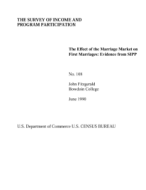The Effect of the Marriage Market on First Marriages: Evidence from SIPP
The Effect of the Marriage Market on First Marriages: Evidence from SIPP
Working Paper Number: SIPP-WP-108
The rise in the number of female-headed families in the U.S. has generated interest in the effects of the Aid to Families with Dependent Children program (AFDC) and other transfer programs on women's choices concerning marriage, childbearing, and employment. This paper looks at marriage rates by never married women using a discrete time hazard model allowing for left and right censoring. It addresses the question of how the marriage market and welfare policy affect marriage rates using an improved measure of spouse availability.
Others in Series
Working Paper
Offer Arrivals Versus Acceptance
The basic job search model implies that unemployment durations are determined by a constant transition rate—the rate at which acceptable offers are received.
Working Paper
Recent Developments in the Survey of Income and Program Participation
Since October 1983, the SIPP has provided both cross-sectional and longitudinal data broadly applicable to analysis of various aspects of economic well-being.
Working Paper
The Elderly and Their Sources of Income
Transfer payments (largely from government programs), and property income (dividends, interest, and rent).
Page Last Revised - October 8, 2021




